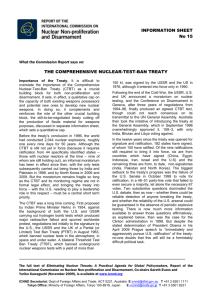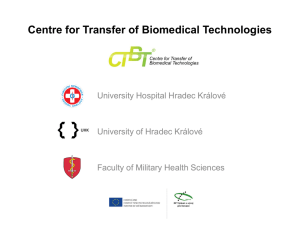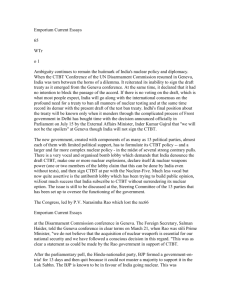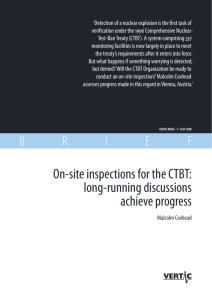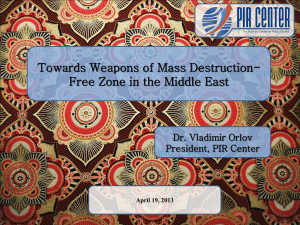Putting the CTBT into practice
advertisement
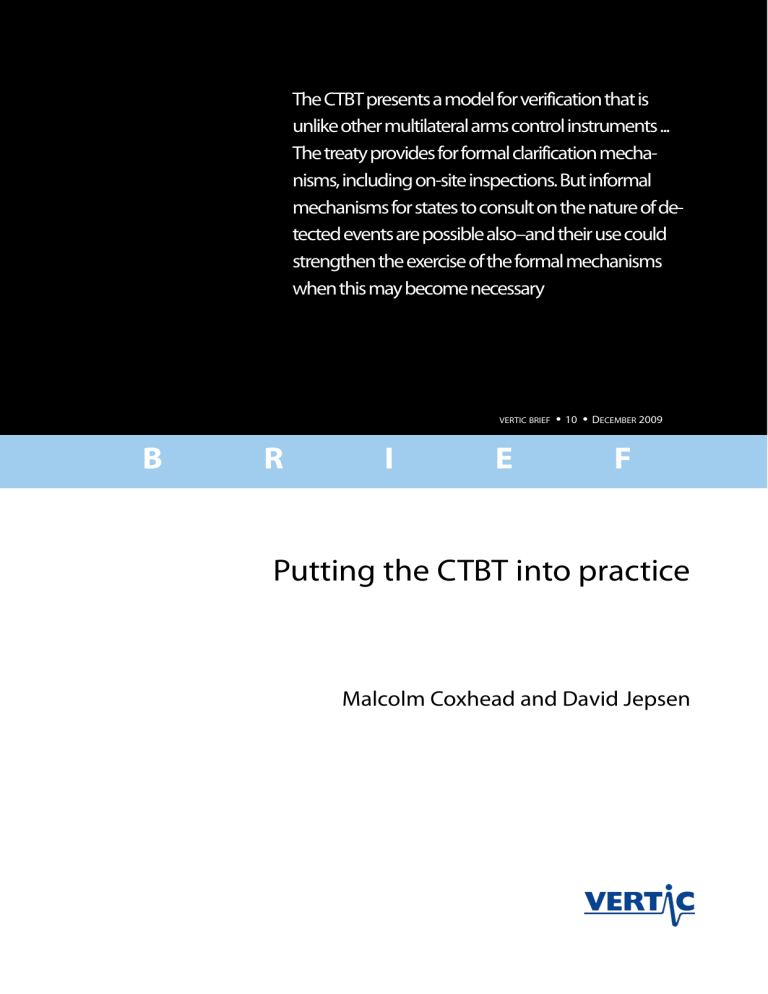
The CTBT presents a model for verification that is unlike other multilateral arms control instruments ... The treaty provides for formal clarification mechanisms, including on-site inspections. But informal mechanisms for states to consult on the nature of detected events are possible also–and their use could strengthen the exercise of the formal mechanisms when this may become necessary VERTIC BRIEF B R I E • 10 • DECEMBER 2009 F Putting the CTBT into practice Malcolm Coxhead and David Jepsen Introduction The verification concept For much of the last fifty five years the The verifiability of the CTBT benefits idea of a comprehensive ban on nuclear from the fact that it bans just one type of weapons tests was just that; an idea. In activity: a nuclear explosion. It benefits 1996 the idea was given legal form in a also from the fact that, as a rule, nuclear treaty: the Comprehensive Nuclear-Test- explosions generate large physical effects. Ban Treaty (CTBT). The political chal- The probability that such effects will be lenge of achieving the 44 ratifications re- detectable at a distance, and will leave last- quired for the CTBT to enter into force is ing local impacts, is high. yet to be completed; however prospects are looking better than in recent years. The CTBT establishes a network of over 300 stations (the IMS) to monitor for the Effective verification is universally re- physical effects of any nuclear explosion. garded as necessary for the CTBT, and Acoustic signals from any terrestrial explo- work to develop concepts and infrastruc- sion are monitored in the earth, in the ture has been underway for quite some oceans and in the atmosphere. Radioactive time. While building the CTBT’s verifica- particulates and gases generated by the tion infrastructure commenced soon after nuclear reaction are monitored in the at- 1996, research on remote monitoring of mosphere. Data from these stations must nuclear tests started many years before. be analysed to pick out events from the Today more than 80% of a functioning background noise. An International Data International Monitoring System (IMS) is Centre (IDC) set up by the CTBT identi- in provisional operation, and planning for fies events and provides details in the form other verification elements, such as on-site of bulletins to States Parties. States Parties inspection (OSI), is well underway. may also obtain the raw data from IMS If the idea of a comprehensive test ban is soon to become a legally binding reality, the task is at hand of actually implementing all that has been planned for and de- stations. States, in turn, operate national data centres (NDCs) to identify and further analyse events that are of interest and possible concern to them. veloped over the years to verify that ban. If a state has serious concerns about a pos- How will CTBT verification work in sible nuclear explosion it may request that practice, and how can we get the best out an OSI is conducted by the CTBT Or- of the legal framework and the technical ganization (CTBTO). An OSI would infrastructure assembled for it? gather information on local impacts of an In this paper we examine the infrastructure that is being set up to support verification of the CTBT, and consider how States Parties can work to fulfill their responsibility of judging compliance with the Treaty. event, to clarify whether a nuclear explosion has occurred. The report of an inspection team would be made available to all States Parties. The Treaty provides that the CTBTO’s Executive Council will address the issue of compliance after reviewing the report of the inspection. In verifying the CTBT, States Parties are 2 • Putting the CTBT into practice Effective verification is universally regarded as necessary for the CTBT, and work to develop concepts and infrastructure has been underway for quite some time. Currently approximately 80% of the stations are in provisional operation by the CTBTO. This already provides quite good coverage, and installation of further stations will fill the gaps that do remain. not limited to relying on the aforementioned sources of information. The Treaty specifically allows for data from national technical means to be considered. In this respect, it is important to note that IMS data can usefully be supplemented by data gathered by extensive networks of seismic stations that have been established by national governments and institutions. Data from other sources could be valuable also. Satellite imagery, including from public sources, may assist with locating and/or clarifying the nature of an event of concern. The IMS When completed the IMS will consist of 321 monitoring stations and 16 radionuclide laboratories. The 50 primary seismic, 120 auxiliary seismic, 11 hydroacoustic, 60 infrasound and 80 radionuclide stations are distributed as evenly as possible over the globe. Such coverage was designed to enable the detection of a nuclear explosion at any terrestrial location, including remote ocean areas where an attempt to clandestinely test might be considered by a proliferator. Use of the four technologies in synergy offers benefits Without prejudice to the right of any both for coverage and sensitivity. For ex- State Party to request an OSI, the CTBT ample, hydroacoustic coverage in the Arc- provides that States Parties should make tic and Mediterranean regions is limited, every effort to clarify and resolve compli- but effective monitoring is possible ance concerns among themselves, or with through seismic detection of signals cou- or through the CTBTO. The Treaty pro- pled from the sea to the land. Conversely, vides explicitly that clarification may be hydroacoustic monitors can offer addi- requested from another State Party, either tional data on some inland events. directly or through the CTBTO’s Executive Council. The concerned state may also ask the CTBTO’s Director General to assist, including by providing information in the possession of its Technical Secretariat. The IMS is designed to reliably provide high quality data to the IDC (and thus states) in near real-time. The CTBTO and station operators need to operate and maintain equipment to high standards, and down-time is kept very low. Logistical Finally, if at any time a State Party has a planning to minimise downtime for sta- concern that a nuclear explosion has oc- tions, and recapitalisation to keep abreast curred, it may raise the concern with the of technology development, are part of CTBTO through its Executive Council, this. Data authentication is applied at which may take action in response. The source to provide assurance against tam- nature of that action is not discussed fur- pering. Assurance that data has not been ther here, but could include referral of the tampered with to hide an event is rein- issue to the UN Security Council. forced also by overlap in the coverage of many stations. Currently approximately 80% of the stations are in provisional operation by the CTBTO. This already provides quite good coverage, and installation of further Putting the CTBT into practice • 3 The Field Information Management System, CTBTO on-site inspection exercise, Kazakhstan, 2008 stations will fill the gaps that do remain. viewed by analysts, they provide a view of The effectiveness of the IMS has clearly recent global events in a timely manner. been shown in its ability to detect the The Reviewed Event Bulletin (REB) prod- North Korean nuclear tests in 2006 and uct contains a comprehensive list of events 2009. These events appear to have been and associated features. Evaluation of IDC quite small when compared to early tests products for the North Korean tests shows carried out by the de-jure Nuclear that they contained timely, accurate infor- 1 Weapon States. The 2006 event high- mation that could be used for verification lighted in particular the value of the noble purposes. gas detection as part of the system. Atmospheric modelling has shown that the noble gas capability of the IMS, when fully installed, will enhance the ability to determine whether an explosive event was nuclear in origin. The IDC The IDC analyses all data from IMS stations and provides daily bulletins and associated products to State Signatories on Final spectra from radionuclide stations are typically made available to the IDC 48 hours after the end of the measurement The 2006 event highlighted in particular the value of the noble gas detection as part of the system. Atmospheric modelling has shown that the noble gas capability of the IMS, when fully installed, will enhance the ability to determine whether an explosive event was nuclear in origin. 1. The de-jure Nuclear Weapon States are defined in article IX.3 of the 1968 Nuclear Non-Proliferation Treaty, which stipulates ‘For the purposes of this Treaty, a day. The IDC runs an automated process nuclear-weapon State is one on these data to generate radionuclide exploded a nuclear weapon spectral reports that can be found in the or other nuclear explosive Automated Radionuclide Report (ARR). 1967’. These states are: As with seismo-acoustic data all the spectra are reviewed interactively and the results of these are found in the Reviewed which has manufactured and device prior to January 1, China, France, Russia, the United Kingdom and the United States. Other nuclear weapon armed states are sometimes referred to as de- Radionuclid Report (RRR). facto nuclear weapon states: acoustic (i.e. seismic, infrasound or hy- A fusion tool to simultaneously view REB Pakistan. droacoustic) data automatically calculated and RRR products has been made avail- solutions can be found in Standard Event able to State Signatories. This provides Lists that are available to State Signatories states with the capability to correlate ra- one, four and six hours behind real-time. dionuclide spectra of concern with seismo While the accuracy of these lists is inferior -acoustic events, and so enables them to to the products that have been fully re- locate the possible origin of an event of events detected by the IMS. For seismo- compliance concern. 4 • Putting the CTBT into practice the DPRK, India, Israel and Judgements about compliance following an OSI are formed by States Parties by analysing data provided in reports of the inspection team. Each State would decide for itself how to analyse these data, however it would be logical for many states to maintain the necessary expertise within NDCs. The IDC also provisionally operates an ducted annually and the results of individ- event screening process. This process, ual analyses are shared at NDC forums. which is mandated in the Treaty, screens Other mechanisms to enhance NDC ca- out events that are considered to be con- pabilities include collaboration on a bilat- sistent with natural phenomena or non- eral or multilateral basis, and the develop- nuclear, man-made phenomena. The ment of regional data centre arrange- screening criteria are designed to give high ments. As we will describe later, strong confidence no nuclear explosion would be cooperation among NDCs can make a key screened out. The events that are not contribution to effective verification of the screened out can be found in the Standard CTBT. Screened Reviewed Event Bulletin. The radionuclide component of this bulletin contains the Level 4 and Level 5 radionuclide products that may be indicative of a nuclear event. The role of NDCs The CTBTO operates the IMS and IDC, and will conduct any OSI, to gather verifi- Judgements about compliance following an OSI are formed by States Parties by analysing data provided in reports of the inspection team. Each State would decide for itself how to analyse these data, however it would be logical for many states to maintain the necessary expertise within NDCs. cation data. However the CTBTO is not The approach to verification under the mandated to form any judgement about CTBT differs from that under the Chemi- treaty compliance. Responsibility for ana- cal Weapons Convention (CWC) or with lysing verification data to form judge- International Atomic Energy Agency ments about the nature of events, and (IAEA) safeguards. In these cases the in- thus treaty compliance, rests with States ternational agency carries out technical Parties. assessment of verification information, For this purpose, states operate national and reports to states on treaty compliance. data centres (NDCs) to identify and ana- The CTBT leaves judgements about com- lyse events that are of interest and possible pliance, and thus on the nature of events concern to them, and to provide technical detected by the IMS, to States Parties at a assessments to their national authorities. technical as well as political level. It calls Each state may choose the level of effort on States Parties to clarify and resolve that its NDC will put into treaty verifica- matters that may cause concern about non tion. An NDC may simply examine IDC -compliance, either through the CTBTO products, available through subscription or among themselves. It refers to NDCs as or from the IDC secure website or it may the places through which states would set up a capability to examine events of process and analyse IMS data and IDC concern itself, or even analyse all raw data products. itself through a system comparable to that Thus NDCs would take on the role of of the IDC. analysing and interpreting verification To help NDCs enhance and/or test their data that in the case of IAEA safeguards capability, preparedness tests are con- and CWC verification rests with the technical secretariat. This presents both a Putting the CTBT into practice • 5 problem and an opportunity for CTBT would also be undertaken. Multispectral States Parties. It means that states need to imaging could also complement visual establish and operate NDCs, and arrange observation by identifying anomalous sur- for cooperation among them. It also face features such as ground or vegetation means that states are free to decide how disturbance. It will also be important to they should do this. Cooperation among begin as soon as possible to monitor for NDCs has been promoted by the shorter-lived phenomena such as seismic CTBTO Preparatory Commission to aftershocks. An early priority will be to build national capacity. As entry into force place seismic monitors to listen for after- approaches, a focus will also be needed on shocks, generated by collapse of an explo- how the task of verifying the CTBT can sion cavity. Satellite imagery, including be promoted through NDC cooperation. that available from open sources, could be OSIs If concerns arise about CTBT compliance, a state may request that an OSI is conducted by the CTBTO to investigate an event. If approved by the Executive Council, the CTBTO would dispatch a team of up to 40 inspectors to gather information in the area that the event took place. The inspection is carried out in a designated area of up to 1000 square kilometres, over a period of up to 130 days. An OSI could be called for any possible nuclear explosion, however the more likely scenario of an underground nuclear explosion is the focus of treaty provisions. Depending on what information is available to an inspection team on the location and nature of the event that triggered the inspection, initial activities on the ground would include a reconnaissance of the inspection area to identify areas of several square kilometres or less for closer investigation. Visual observation from the very valuable for focusing inspection activities. Guided by initial search results, the inspection team can use a range of geophysical techniques (ground penetrating radar, magnetic and gravitational field mapping) to search for and characterise subsurface anomalies. Active seismic techniques and electrical conductivity measurements could be used to identify and image such anomalies, including a deep explosion cavity. Geophysical techniques are potentially powerful, but are not well suited to wide-area searches. Information to closely locate the triggering event, including from national technical means could play an important role. The detection of radioactive gases and particulates consistent with a nuclear explosion would provide clear evidence of non-compliance. Ideally these would be gathered by drilling to obtain samples from an explosion cavity. ground and air would aim to identify arte- Reports of the inspection, which could facts of an underground nuclear explosion include numerous technical findings, such as equipment or works that may be would be made available to all States Par- associated with a test, as well as evidence ties for their analysis. The Executive of ground disturbance such as cracks. Sur- Council would review the reports, for vey of gamma radiation levels, and sam- which purpose Council members would pling for radioactive gases or particulates, need to be briefed by technical agencies 6 • Putting the CTBT into practice If a violator has succeeded in fully containing a nuclear explosion, and in hiding associated cultural artefacts, the search could be more difficult. However, if additional information, such as satellite imagery, can give an accurate location, a deep cavity could be located with geophysical techniques. The IMS is designed to provide verification data that is objective in character. Measurements of the seismic, radionuclide, infrasound or hydroacoustic signals are made by sensors whose location and specifications are subject to multilateral agreement. such as the National Data Centre. The range of techniques available to inspectors should find signs of an underground test that has not been fully contained. Any surface expression of a nuclear explosion, such as ground cracking, release of radioactive gases or particulates, or the presence of test-related equipment or works ought to be detectable. IDC, which are tools of routine verification for the CTBT. Additional information could be offered by States Parties, to support the inspection request, and to help to define the character of the event. This is different to the situation with CWC challenge or IAEA Special Inspection. There, a request is more likely to rely on information primarily from national technical means (and not from routine If a violator has succeeded in fully con- verification activities) to demonstrate that taining a nuclear explosion, and in hiding something of concern exists, and could associated cultural artefacts, the search thus be subject to political controversy. could be more difficult. However, if additional information, such as satellite imagery, can give an accurate location, a deep cavity could be located with geophysical techniques. The IMS is designed to provide verification data that is objective in character. Measurements of the seismic, radionuclide, infrasound or hydroacoustic signals are made by sensors whose location and Would OSIs be used? specifications are subject to multilateral It has been noted that the CTBT’s re- agreement. Authentication signatures are quirement that an OSI is approved by at generated for data at its source to provide least 30 of the 51 members of the Execu- assurance against tampering. Most events tive Council could present a roadblock to of interest for CTBT would be detected the use of this aspect of the Treaty. It is by several IMS stations, usually located in the case that ‘anywhere-anytime’ inspec- different countries. tion mechanisms under multilateral non- If an event of concern is detected by sev- proliferation and disarmament instru- eral IMS stations, the fact of the event ments have not been well used. However, should not be in dispute, and the risk that issues surrounding a decision on CTBT a corresponding OSI request is abusive in OSI could be materially different to those intent should be small. What may not be affecting other types of ‘anywhere-anytime settled is how to interpret the available inspection’. In particular, objective verifi- data. Differing explanations might be cation information from the IMS and proffered for an event; however there IDC would be likely to be available to would be an impetus to find an explana- support a decision. Even if the meaning of tion that is satisfactory. For seismic, infra- such information may be subject to inter- sound and hydroacoustic data, any differ- pretation, the fact of an event of possible ences would revolve around the location concern, and needing investigation, (including depth), size and explosive char- should be clear. acter of the event. If radionuclide data It is likely that any event which could be consistent with a nuclear explosion is the trigger for an OSI request would have available, the case for an OSI would be been detected and located by the IMS and considerably strengthened (if such clarifiPutting the CTBT into practice • 7 cation is still considered necessary). Detection, clarification and deterrence Two basic objectives of verification are to detect non-compliance, and to deter possible non-compliance by creating the risk that it will be detected. Under the CTBT detection of non-compliance should be understood as having two parts. The first is the technical function of detecting an event; the second is analysis of the event to clarify its nature. The verifiability of the Treaty is often spoken of in terms of ability to detect a nuclear explosion, espe- times each day. To identify a possible nuclear test among these requires effective screening processes to pick out seismoacoustic events showing characteristics of an explosion, and if possible to relate an event to a detection of particular radionuclides. The frequency of events that form the background noise, whether from natural or man-made sources, increases as their size decreases. Quite small events could be detected by IMS stations in many places, but picking these from the background, and gathering enough information to characterise them, is what sets limits for its capability. cially smaller explosions. However, the The IMS and the IDC carry out the first day-to-day challenge of CTBT verification step of detecting and screening events to is not the ability to detect an event, but identify those that may require further the task of identifying an event of concern investigation, and report around 100 such among the noise of other (mostly natural) events each day (some states may do this events. screening also). The step of more closely Our planet is a seismically active place. Events with a seismic magnitude similar to that of a small nuclear test occur many Inspector on watch, CTBTO on-site inspection exercise, Kazakhstan, 2008 8 • Putting the CTBT into practice analysing and forming judgments on the nature of events is the task of NDCs. As has been mentioned, how states choose to Ongoing and collegiate activity by NDCs to analyse ambiguous events would help to establish as normal the objective of clarifying the nature of events, and lead naturally to the use, where appropriate, of the clarification mechanisms that are explicit in the Treaty. Although no explicit mechanism for it is included in the CTBT, technical cooperation among NDCs to clarify the nature of the many detection events that occur each day should be an important way for States Parties to fulfill their verification role. do this analysis is up to them. In most It is important however for the effective cases the analysis would be a straightfor- verification of the CTBT that their poten- ward technical procedure, but for some tial is able to be realised. events additional efforts may be needed to clarify its nature. This could include use of the consultation and clarification provisions in the CTBT, or even an OSI. Ongoing and collegiate activity by NDCs to analyse ambiguous events would help to establish as normal the objective of clarifying the nature of events, and lead If the CTBT's verification mechanism is naturally to the use, where appropriate, of to be effective in deterring non- the clarification mechanisms that are ex- compliance, the processes of detecting and plicit in the Treaty. Such activity could screening to identify events of possible also help to establish a sound, and widely concern, and then of clarifying their na- accepted technical case for use of Treaty ture need to work well. Infrastructure for mechanisms such as OSI. This could be detecting and screening events, in the contrasted with a situation where NDCs form of the IMS and the IDC, is well on work largely alone, and where concerns its way to completion and is performing about an event may appear to arise “out of well. Ongoing work to clarify the nature the blue”. of events is what will be needed after entry into force of the Treaty to make the system work. Mostly this work will be done by States Parties through their NDCs, but should also include appropriate use of consultation and clarification and of OSI. Exercising the Treaty If data from the IMS and IDC clearly indicates that an event with the characteristics of a nuclear explosion has taken place, and locate it in a particular State Party, the international community might, in The use of the CTBT’s clarification provisions, most likely on a bilateral basis, could also help to address concerns that have sometimes been raised about so called low-yield tests. Measures could be developed between concerned states to give confidence that nuclear experiments have not resulted in a nuclear explosion. While the CTBT’s OSI mechanism could, in principle, be invoked to investigate such concerns, states may be more comfortable with bilateral arrangements. principle, conclude that the state has acted contrary to Treaty obligations. However such a conclusion would probably require additional evidence. As mentioned, the CTBT's consultation and clarification, and the OSI mechanisms provide ways to obtain additional information. However, there is a risk that use of these mechanisms could be eschewed due to political sensitivities. Related provisions under the Chemical Weapons Convention have not been used. Putting the CTBT into practice • 9 NDC cooperation Effective implementation of the injunction in Article IV of the CTBT that States Parties should make every effort to clarify help to maintain the capacity of NDCs, and allow a coordinated and technically sound response if an event of serious concern is detected. and resolve compliance concerns among The risk that a detected event poses might themselves will be at the heart of day-to- be assessed from two factors: to what ex- day verification of the Treaty. Although tent the event possesses characteristics no explicit mechanism for it is included in similar to a nuclear explosion; and the the CTBT, technical cooperation among availability of an alternative explanation NDCs to clarify the nature of the many for the event. If an event is assessed as pre- detection events that occur each day senting some risk, but not enough to war- should be an important way for States rant some action under treaty provisions, Parties to fulfill their verification role. States Parties could cooperate through As has been mentioned, events with some of the attributes of a nuclear explosion are detected by the IMS and IDC quite frequently. Often it would be easy for States Parties, through their NDC, to determine the likely nature of an event – and thus dismiss it as not relevant to CTBT compliance. At other times additional views or information might be needed. Such assistance could, at one end of the scale, be afforded through cooperation among NDCs. Use of Treaty mandated clarification procedures would be a further option. At the other end of the scale an OSI may be judged necessary. NDCs to study it. The results of such studies would help NDCs to build models against which future events could be assessed. If the risk is assessed as higher, States Parties could (individually or in cooperation) use the consultation and clarification provisions of the CTBT to seek more information. Again, the results could be examined cooperatively by NDCs. If States Parties consider that the risk posed by an event may warrant the request for an OSI the existence of cooperative arrangements among NDCs could help to ensure the request has a sound technical basis. As entry into force approaches, CTBT Conclusions States Parties, working through their The CTBT presents a model for verifica- NDCs, should develop processes of coop- tion that is unlike other multilateral arms erative engagement to examine events of control instruments. As preparations have possible concern that are detected by the been made for the Treaty's entry into IMS (or by other means), as well as proc- force, focus has naturally fallen on the esses for studying the nature of such development of verification infrastructure events in general. Such cooperation such as the IMS, IDC and OSI. National among NDCs should not constrain the Data Centre capacity has also been en- ability of any CTBT State Party to exer- couraged. Concepts for the integrated use cise its rights (or obligations) as it sees fit. of all these components to verify a CTBT But by working together the effectiveness that is in force has been less in focus. The of CTBT verification would certainly be responsibility for effective integration will enhanced. Routine interaction should not lie with the future CTBT Organiza- 10 • Putting the CTBT into practice Effective implementation of the injunction in Article IV of the CTBT that States Parties should make every effort to clarify and resolve compliance concerns among themselves will be at the heart of day -to-day verification of the Treaty. The responsibility for effective integration will not lie with the future CTBT Organization, but with its States Parties. As entry into force of the CTBT approaches, states need to consider how they will do this. tion, but with its States Parties. As entry into force of the CTBT approaches, states need to consider how they will do this. The purpose of the IMS and IDC is to gather and screen monitoring data to identify events. Many events are identified each day and notified to states. The key role of NDCs is therefore to sift the events further to find any that might have characteristics of a nuclear explosion. To then go the next step, and clarify the nature of an event may not be easy. The CTBT provides for formal clarification mechanisms, including OSI. But informal mechanisms for states to consult on the nature of detected events are possible also–and their use could strengthen the exercise of the formal mechanisms when this may become necessary. Glossary AAR Automated Radionuclide Report CTBT Comprehensive Nuclear-Test-Ban Treaty CTBTO Comprehensive Nuclear-Test-Ban Treaty Organization CWC Chemical Weapons Convention IAEA International Atomic Energy Agency IDC International Data Centre IMS International Monitoring System NDC National Data Centre OSI On-Site Inspection REB Reviewed Event Bulletin RRR Reviewed Radionuclide Report Putting the CTBT into practice • 11 Editor, design & production Andreas Persbo About this paper Printing and distribution Electronic distribution only. May be printed on demand. Best viewed on double side print in full colour. This brief examines the practical application of the various elements of the CTBT verification regime, their interplay, and suggests a model for technical interaction among States Parties to facilitate verification. © VERTIC 2009. Malcolm Coxhead is the Section Head for CTBT implementation at the Australian Safeguards and Non-Proliferation Office (ASNO), responsible Parts of this paper were contributed by Malcolm Coxhead to, and appear in, the International Commission on Nuclear Non-proliferation and Disarmament for implementation of CTBT obligations and oversight of the InternaReport, ‘Eliminating Nuclear Threats: A Practical Agenda for Global Policymak- tional Monitoring System in Australia. He has led the process to elaborate a draft OSI Operational Manual in CTBT Preparatory Commission’s ers’, available at www.icnnd.org Working Group B since mid-2004. VERTIC Development House 56-64 Leonard St. London EC2A 4LT United Kingdom T +44-20-7065 0880 F +44-20-7242 0890 E info@vertic.org www.vertic.org building trust through verification David Jepsen is the leader of the Nuclear Monitoring Project at Geoscience Australia, responsible for monitoring nuclear explosions worldwide and supporting the establishment of the CTBT verification system. From 1997-2007 he led the IDC Experts Group on seismo-acoustic Event Screening in the CTBTO Preparatory Commission. DIRECTORS David Keir Andreas Persbo, Acting Executive Director Edward Ifft Angela Woodward, Programme Director Graham Pearson Joy Hyvarinen PERMANENT STAFF Nomi Bar-Yaacov Larry Macfaul, Senior Researcher Odette Jankowitsch-Prevor Scott Spence, Senior Legal Officer Patricia Lewis Rocio Escauriaza, Legal Officer Richard Butler Hassan Elbahtimy, Research Assistant Robert J. Mathews Unini Tobun, Administrator Robert Kelley VOLUNTEERS & INTERNS FUNDERS, as of 1 December 2009 Jasper Pandza, Volunteer (2009-10) Chatham House Meena Singelee, Volunteer (2009-10) Ford Foundation Matthew McGinn, Intern (September-December 2009) Netherlands Ministry of Foreign Affairs David, Cliff, Intern (November 2009-January 2010) Norwegian Ministry of Foreign Affairs Ploughshares Foundation BOARD OF TRUSTEES Sandia National Laboratories Sir Hugh Beach, co-chair UK Foreign & Commonwealth Office Owen Green, co-chair US State Department Molly Anderson, member Wyn Bowen, member VERTIC BRIEFS Duncan Brack, member otherwise stated, views herein are the responsibility of the Nicholas Sims, member author and does not necessarily reflect those of VERTIC or its Susan Willet, member staff. Published under a non-exclusive copyright license given are published on an ad-hoc basis. Unless by Geoscience Australia of the Australian Government. May INTERNATIONAL VERIFICATION CONSULTANTS NETWORK not be reproduced without express permission from Geo- Arian Pregenzer science Australia. Rosalind Reeve Colin McInnes ISSN 0966-9221.
